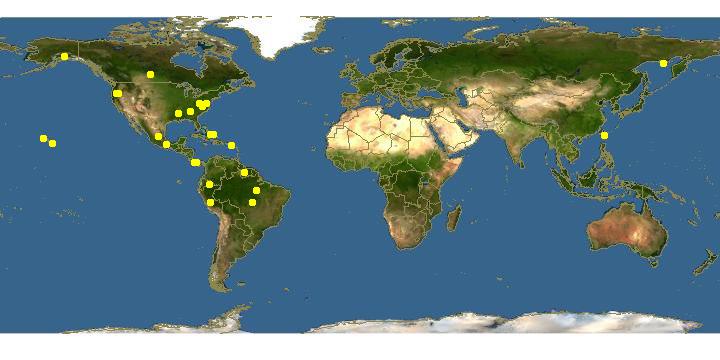
Click on map for details about points.
|
|
Overview | |
Cultivated upon substrates such as 0.1L-P, 0.1G-P, 0.1L-P (pH 6.0)/2, and weak hay infusion agars in association with Escherichia coli at 22-27 C. Sorocarps solitary or in small clusters, white, erect or semi-erect, richly branched, typically symmetrical, commonly 3-8 mm high but sometimes more, weakly phototropic; sorophores uncolored, often 2-4 cells thick near the base and 12-30 Ám in diam., tapering upward to a single tier of cells 5-8 Ám wide at the terminal sorus, bearing 3-8 or more fairly evenly spaced whorls of lateral branches, mostly 3-6 branches per whorl; branches often 300-400 Ám in length, occasionally rebranched with each branch or branchlet bearing a small sorus at its tip. Sori white to hyaline, of two classes, terminal sori globose or slightly citriform, mostly 75-150 Ám in diam.; lateral sori globose and smaller, about 40-65 Ám in diam. Spores elliptical to slightly reniform , mostly 5.0-7.0 x 2.5-3.0 Ám, occasionally up to 8 x 4 Ám, polar granules unconsolidated but clearly evident. Cell aggregations radiate in pattern, generally small, fairly compact, with streams often ending abruptly, commonly 1-2 mm in diam. and producing one or more sorocarps; pre-aggregative myxamoebae 13-18 x 9-14 Ám, often with two or more contractile vacuoles that mayor may not coalesce before discharging; aggregating cells elongate and oriented uniformly toward aggregation centers. Macrocysts produced by paired strains of compatible mating types, less commonly by self-compatible strains; unaggregated myxamoebae commonly form globose to subglobose microcysts 4.0-5.5 Ám in diam. Cells aggregate in response to glorin, the acrasin of P. violaceum.
|
|
|
Links to other sites | |
|
|
|
Acknowledgements | |
The Eumycetozoan Project -- working to understand the ecology, sytematics and evolution of myxomycetes, dictostelids and protostelids -- the true slime molds.
Sponsored by grants from the National Science Foundation.
|
|
|
Feedback |
Please send any corrections and comments about this page to John Shadwick
Department of Biological Sciences, University of Arkansas, Fayetteville, AR 72701, USA
email: jshadwi@uark.edu
phone: USA-479-575-7393.
|
|
| Supported by | |
Updated: 2024-05-05 19:30:33 gmt
|